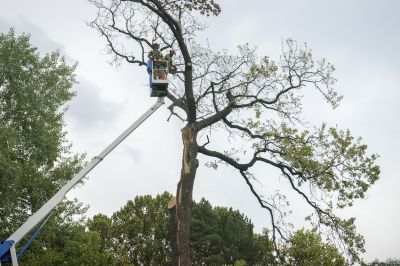Favorite Equipment for Professional Tree Removal Services
Equip your team with the most recommended tools and machinery to tackle tree removal jobs with confidence.
 Tree removal services require specialized equipment to ensure safety and efficiency. The selection of appropriate tools can make a significant difference in the ease of the process and the safety of personnel involved. From handheld tools to heavy-duty machinery, there is a wide array of products designed to facilitate various aspects of tree removal, including cutting, trimming, and debris cleanup. Properly choosing these tools depends on factors such as tree size, location, and the complexity of the removal task.
Tree removal services require specialized equipment to ensure safety and efficiency. The selection of appropriate tools can make a significant difference in the ease of the process and the safety of personnel involved. From handheld tools to heavy-duty machinery, there is a wide array of products designed to facilitate various aspects of tree removal, including cutting, trimming, and debris cleanup. Properly choosing these tools depends on factors such as tree size, location, and the complexity of the removal task.
Top Overall Option
Heavy-Duty Gas-Powered Chainsaw
A versatile and powerful chainsaw designed to handle large tree limbs and trunks efficiently. It offers high cutting capacity, durability, and ease of handling for various tree removal tasks, making it a reliable choice for professionals and serious DIY enthusiasts.
Types of Products For Tree Removal Service
Manual Hand Pruners
Ideal for trimming smaller branches and detailed work, manual pruners are essential for precise cuts and shaping.
Pole Pruners
Extend your reach to trim high branches without climbing, suitable for medium-sized limbs.
Chainsaws
Power tools designed for cutting through thick branches and trunks efficiently, available in electric, battery, and gas-powered options.
Reciprocating Saws
Useful for cutting through roots and smaller branches in tight spaces, especially during stump removal.
Stump Grinders
Heavy machinery used to grind down tree stumps after removal, facilitating land clearing and replanting.
Rope and Rigging Gear
Essential for controlled descent of large branches and trunks, ensuring safety during removal.
Climbing Harnesses
Safety equipment for arborists to ascend and work securely on tall trees during removal.
Loppers
Long-handled cutting tools suited for trimming thicker branches at a comfortable height.
Debris Chutes
Devices that help safely guide branches and debris down to ground level during pruning or removal.
Protective Gear
Includes helmets, eye protection, gloves, and chaps to ensure safety during all phases of tree removal.
Lifting Equipment
Cranes or hoists used to lift heavy trunks or large branches safely from difficult locations.
Chainsaw Accessories
Bars, chains, and lubricants that enhance chainsaw performance and longevity.
Tree Removal Kits
Comprehensive sets that include multiple tools and safety gear for complete removal tasks.
Hydraulic Cutters
Powerful tools used to cut through very thick wood or steel cables during complex removals.
Popular Choices
Convenient and portable, suitable for small to medium tree trimming and removal tasks.
Handheld saws for precise cuts on smaller branches, favored for detailed trimming.
Popular for removing stumps efficiently, especially in landscaping projects.
Complete safety and climbing gear sets preferred by professional tree workers.
Trending for their reach and ease of use in trimming high branches without ladders.
Highly recommended for safety during cutting and trimming operations.
Popular for cutting high branches from the ground, combining reach with power.
Hand tools for trimming medium to thick branches with ease.
Setups for controlled branch descent, increasingly used in professional removals.
Helpful for collecting and transporting debris efficiently during removal.
Facilitate gripping and lifting large trunks safely, gaining popularity among professionals.
Essential for secure climbing and work at height, frequently chosen by arborists.
Accessories for detailed carving and trimming in tree removal projects.
Machines used to grind and clear large areas of woody debris after removal.
Safety is paramount in tree removal, and using the right protective gear alongside the correct equipment can help prevent accidents. Equipment options range from manual hand saws and pruners to powered chainsaws and stump grinders. For larger trees, specialized rigging gear and climbing equipment are essential for controlled and safe removal. Maintenance and proper handling of these tools are equally important to ensure longevity and optimal performance.
Understanding the different types of products available can aid in planning a successful tree removal operation. It is advisable to consider the scope of the job, the environment in which the work will take place, and the skill level of the operators. Investing in quality tools can also reduce the effort required and improve overall safety standards. Whether for professional arborists or dedicated homeowners, selecting the right equipment is a crucial step in achieving a clean and safe removal process.
Key Buying Considerations
- Tree size and trunk diameter to determine the power and capacity needed.
- Type of equipment suitable for the specific removal task, such as manual or powered tools.
- Safety features and protective gear compatibility to ensure safe operation.
- Ease of handling and maneuverability, especially in tight or difficult-to-access areas.
- Power source preferences, including electric, battery, or gas-powered options.
- Durability and build quality to withstand demanding outdoor conditions.
- Maintenance requirements and availability of replacement parts.
- Operator skill level and whether professional or DIY tools are appropriate.
- Storage and transportation considerations for larger equipment.
- Budget constraints balanced with quality and safety features.
- Compatibility with other tools and accessories used in the removal process.
- Noise levels, particularly in residential or noise-sensitive areas.
- Availability of warranties or customer support from the manufacturer.
- Environmental factors, such as terrain and accessibility, influencing equipment choice.
- Regulatory compliance and safety standards relevant to the region.
